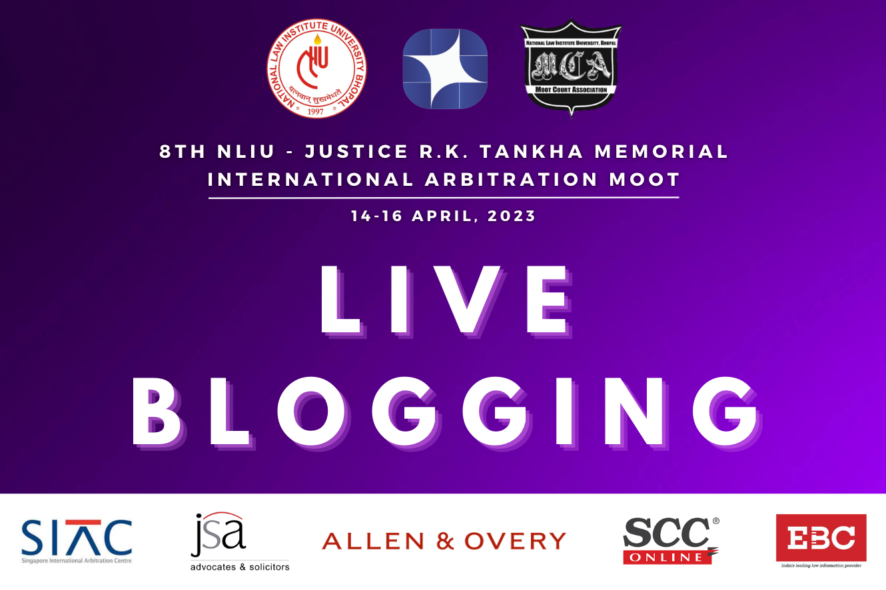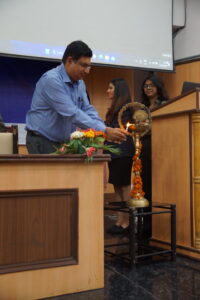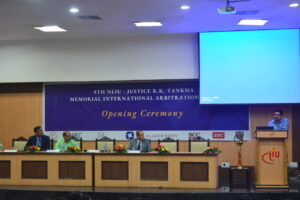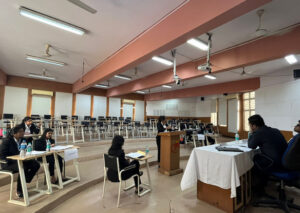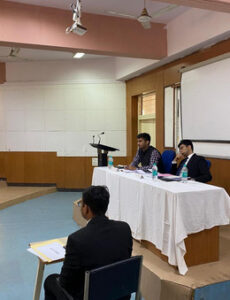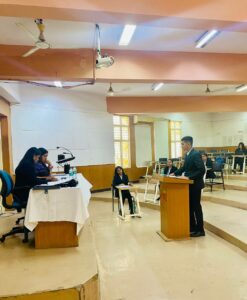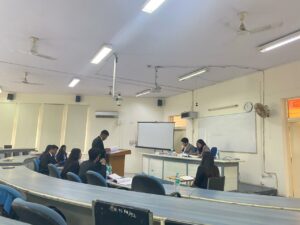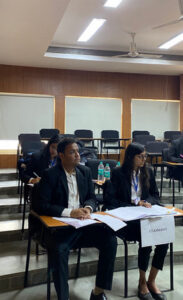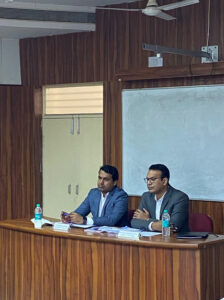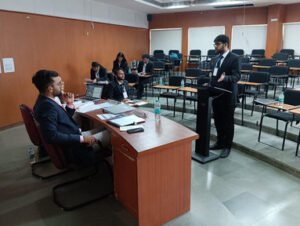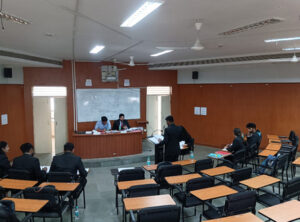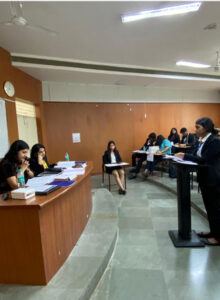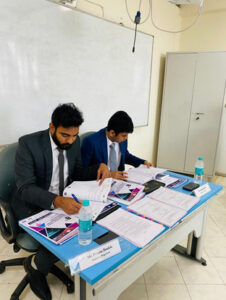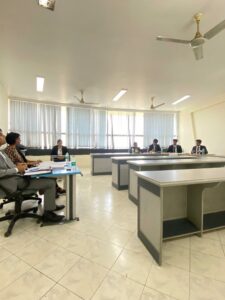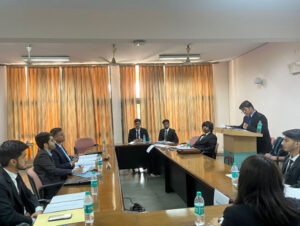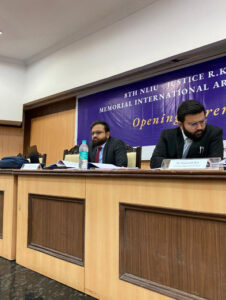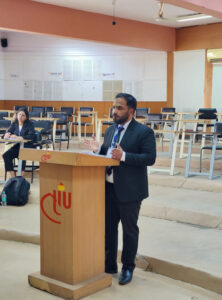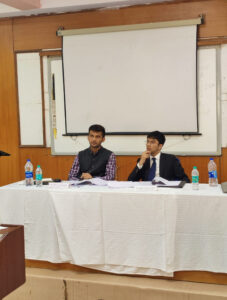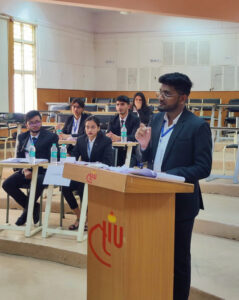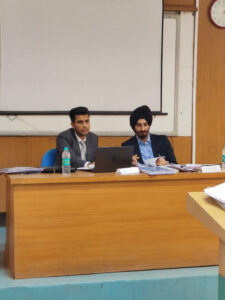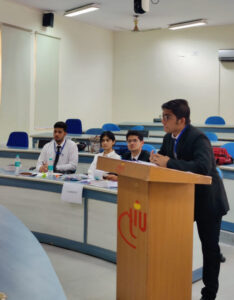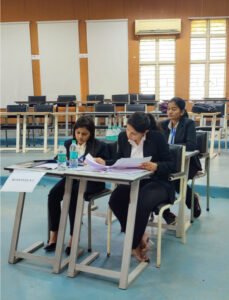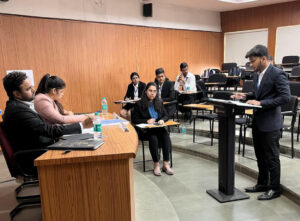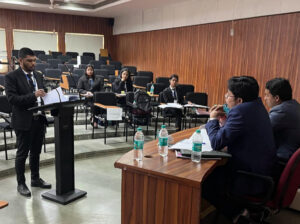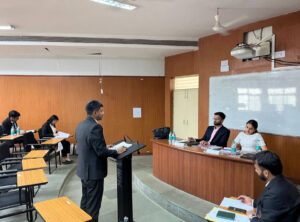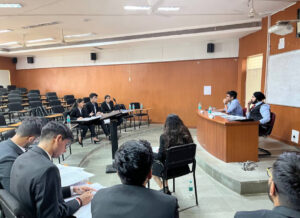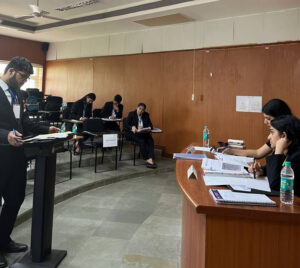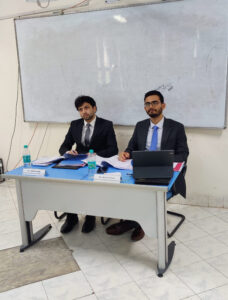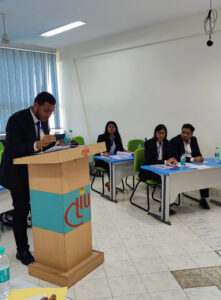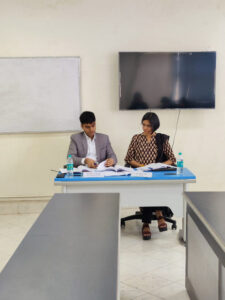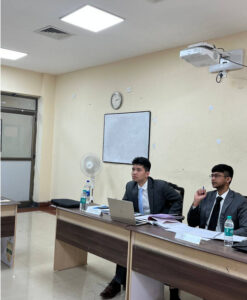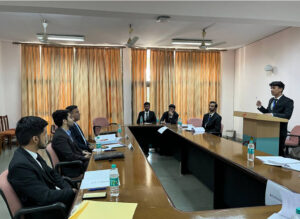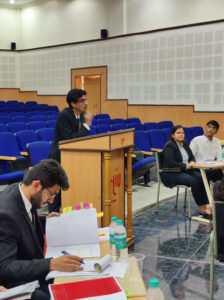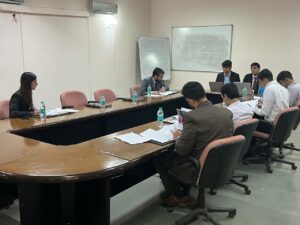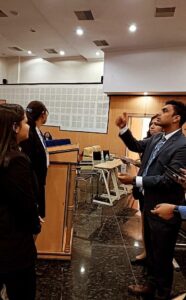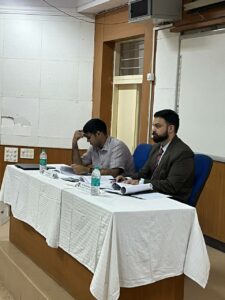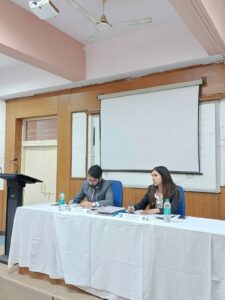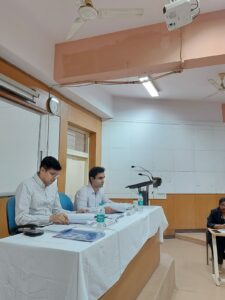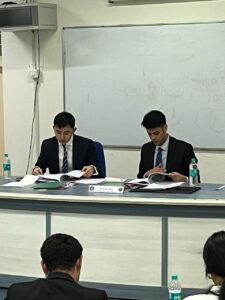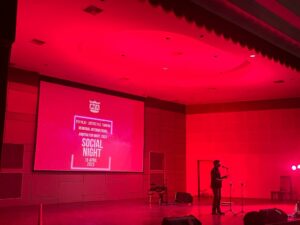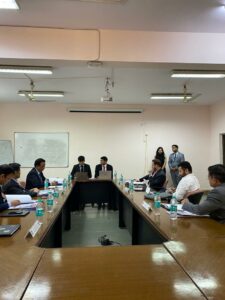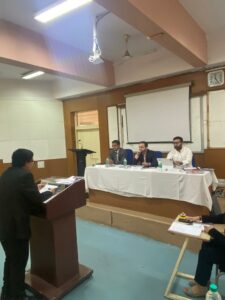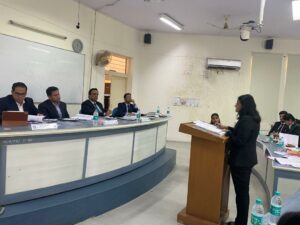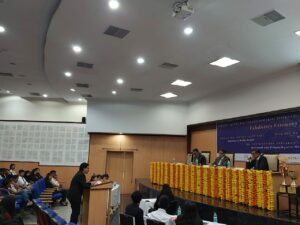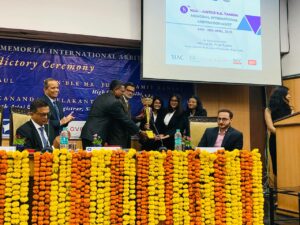The National Law Institute University, Bhopal has pioneered holistic legal education in India and has consistently worked towards incorporating clinical legal education into its curricula. The Moot Court Association (“MCA”) of National Law Institute University (“NLIU”) is the oldest student association of the Institute and is the official body which oversees all mooting and related activities in the institute. The NLIU- Justice R. K. Tankha Memorial International Arbitration Moot is the flagship event of the MCA and is organized annually in partnership with the Office of Mr. Vivek Tankha, Member of Parliament and Senior Advocate as a tribute to the Late Hon’ble Justice Mr. R.K. Tankha.
With the Singapore International Arbitration Centre (SIAC) as its Institutional Partner, J. Sagar Associates as its Indian Law Firm Partner, Allen and Overy as its Research Partner and SCC Online as its Knowledge Partner, the MCA is thrilled to announce the 8th Edition of the NLIU- Justice R. K. Tankha Memorial International Arbitration Moot.
Aiding it in its pursuit of excellence are organizations such as Racial Equality for Arbitration Lawyers (R.E.A.L.), Brazil Very Young Arbitration Practitioners (BRVYAP), Energy-Related Arbitration Practitioners (ENERAP), London Very Young Arbitration Practitioners (London VYAP), and Tales of the Tribunal (ToT), who have graciously joined the event as Friends of the Moot.
The three-day event will offer participants from across the country an opportunity to expand their networks and hone their skills through insightful lectures and challenging Moot Court rounds.
Stay tuned for live updates!
14th April 2023- Day 1
2 PM | Registration | Auditorium
The organizing team is all set to welcome the participating teams with the registration desk piled up with folders. After collecting their respective folders, the teams move outside for a quick break before the inauguration ceremony.
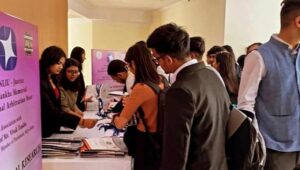
The ceremony commences with the Vice Chancellor’s address who asks the law students gathered to acknowledge the ever-rising presence of Artificial Intelligence in the field of law. He concludes by thanking Dr. Sumeet Malik for joining the ceremony. Dr. Sumeet Malik advises students that in order to become successful lawyers one must hold a hunger to learn, be able to deal with situations, respond to queries appropriately, and have empathy.
The Vice Chancellor felicitates Dr. Sumeet Malik with the NLIU’s Silver Jubilee edition of the copy of the Constitution and declares the competition open.
After the opening session, a special session by Dr. Sumeet Malik commences. He begins by saying that good legal research is imperative to be successful in a legal career. He also comments that the law is subject to change; hence, a lawyer must be abreast with the changes in the law and have good analytical skills.
He presents a hypothetical situation to make the session interactive and help the participants understand the nitty-gritty of good legal research. He asks the participants questions, and students are encouraged to present the possible views of both parties in the hypothetical situation being discussed. The session proceeds with a constructive and enriching discussion.
He elucidates on how to read judgments from the SCC Digests and educates the participants about the useful features of SCC Online. He also explains how the students may enhance their legal research through the platform, and the session concludes after a quick Q&A session.
The second academic session on Commercial Litigation and Arbitration in India by Mr. Pratik Pawar, Partner at J. Sagar Associates, and Ms. Maitreyi Kannur, Senior Associate at J. Sagar Associates begins.
Mr. Pratik Pawar, the first presenter for the session begins by introducing arbitration, and its significance in India. Mr. Pawar poses another question to the audience about where does one’s role as an arbitration lawyer begin. A student answers that the same begins with drafting an arbitration agreement, and he further explains the stages of the arbitration process. Mr. Pawar suggests an arbitration practitioner to always follow the stages of “Strategy-Investigation-Advocacy-Case Management” in order to effectively fulfil one’s role as an arbitration lawyer.
Ms. Maitreyi Kannur begins the latter part of the session with a question on the first course of action as an arbitration practitioner as a respondent’s representative. She initiates a discussion on Section 16 of the Arbitration Act.
Ms. Kannur adds that in the events of the commencement of an arbitration, it is also important to note the circumstances of an arbitration, from negotiations to the communication of settlement disputes. Furthermore, Ms. Kannur talks about what evidence is and the lifecycle of the same in arbitration. From affidavit evidence, evidence marking, and evidence filing to cross-examination. The session concludes with students asking questions regarding the arbitration process.
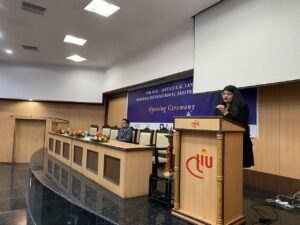
4:15 PM | Academic Session – 3 | Auditorium
The final session for the day, to be conducted by the esteemed drafters of the Case Record, Mr. Godwin Tan and Mr. Pranay Lekhi, Associates at the London office of Allen and Overy, begins with Mr. Lekhi elaborating upon the history of international commercial arbitration. Starting from the ancient Vedic era’s arbitration to King Solomon – the biblical arbitrator, he explains the evolution of arbitration and the modern conception of arbitration; the Geneva Convention in 1923 and the New York Convention.
Mr. Lekhi and Mr. Tan explain the features of the leading arbitration hubs and the characteristics which make them preferred seats of arbitration. Furthermore, they explain the grounds under which arbitral awards can be challenged: jurisdiction, irregularity in the arbitral award, and the question of law. The session concludes with the quote, “The ideal of arbitration is freedom reconciled with law.”
The session is quite interactive and stimulating and one of the participants asks “What is the difference between arbitration institutions and the seat of arbitration?”, the answer to which is that an arbitration institution is a permanent organization with a set of its own arbitration rules regulating the services and other procedural aspects whereas the seat of arbitration is a location selected by the parties which consequently determines the procedural framework of the arbitration.
The session concludes and a vote of thanks is given to Mr. Godwin Tan and Mr. Pranay Lekhi, and saplings, as well as a commemorative copy of the Indian Constitution, are presented to them by Asst. Prof. Amit Pratap Singh, as a form of appreciation and gratitude for the engaging and stimulating session.
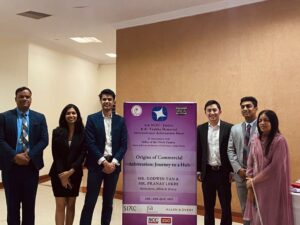
7:30pm | Fixtures and Memorial Exchange | Auditorium
The fixtures for the preliminary rounds are announced and the memorials have been exchanged. During the exchange of memorials, the teams received the memorials of their opponents for tomorrow’s preliminary rounds.
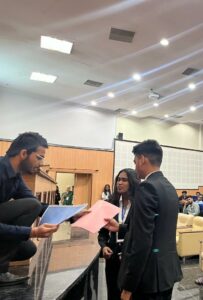
15th April 2023- Day 2
9:30 AM | Judges Briefing | Auditorium
Day 2 begins with the Judges’ Briefing by Mr. Aryaman Vachher and Mr. Karthik Sarma, fourth-year students of the University. Once the matchups for the preliminary rounds are announced, Mr. Sarma deals with the substantive issues of the problem. He briefly mentions the material facts of the problem. Mr. Vachher then deals with the procedural issues of the moot, identifying the possible questions that could be asked during the round. The briefing concludes and the judges head to their respective courtrooms, to begin the first preliminary rounds.
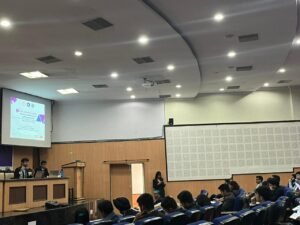
11:15 am | Preliminary Round 1
Courtroom 1 – Team 31 v. Team 3
The arbitrators of the round are Mr. Anuj Shrivastava and Mr. Milind Ghosh. The round begins with the first speaker from the respondents being posed a question regarding the Indian Laws gaining pertinence over the English Laws in the case at hand. The discussions range from the Indian Limitations Act to the applicability of the English laws in the present case. The round is closed after a round of rebuttals and constructive feedback from the judges.
Courtroom 2 – Team 1 v. Team 9
The arbitrators of the round are Mr. Aaditya Shankar Dixit and Mr. Aishwarya Choudhary. From the very outset, several questions are posed to the speakers ranging from questioning the severability of an arbitration agreement to the role of the mentor-mentee relationship in business. The claimants are questioned on the neglect of mentioning the issue of breach of contract in their memorial, even before permission to present the claimant arguments is sought. Finally, both the teams rebut each other and the round is closed.
Courtroom 3– Team 20 v. Team 5
The arbitrators for the courtroom are Ms. Sakshi Pawar and Ms. Meenakshi Kumar. They begin by taking a detailed look at the memorials of the respective teams. The implied capacity of the part-time directors is discussed and it is put forth that no implied authority has been conferred on the claimant to execute the agreement. The claimants contend that they have suffered significant losses due to the actions of the respondents. The arbitrators conclude the round by providing words of encouragement as well as constructive criticism to the teams.
Courtroom 4– Team 10 v. Team 24
The arbitrators of the round are Mr. Sabarvir Oberoi and Mr. Akshit Vohra. The respondents argue that there is no time bar for filing claims for misrepresentation, considering that the time period between the negotiations and filing of arbitration was approximately 6 years. They take the aid of various provisions of the Limitation Act and relevant cases to substantiate their claims. The arbitrators question the claimants regarding the status of the contract, to which the claimants respond by stating it is an international sales contract. They contend that neither suspension nor extension of the agreement would be contrary to the general rules as established in English laws. A round of rebuttals begins and the round concludes with the arbitrators providing feedback to the teams.
Courtroom 5– Team 38 v. Team 21
The arbitrators of the round are Mr. Akshit Saigal and Ms. Ritu Anand Vishwakarma. The Counsel for the Respondent extensively argues to establish the invalidity of the arbitration agreement. The counsel for Claimant responds by relying on the doctrine of separability and the principle of Kompetenz-kompetenz. The counsel further relies on precedents to argue the doctrine of separability. The judges quite exhaustively question both parties on the facts of the case, and the round concludes with rebuttals.
Courtroom 6– Team 23 v. Team 27
The arbitrators of the round are Mr. Kanishka Gupta and Ms. Devyani Gupta. The parties have agreed for the Respondents to lead on procedural issues of the case, followed by the Claimant to lead on the merits of the case. The counsel for respondents begins by providing a brief roadmap of their submissions. The arbitrators request a brief overview of the facts. The counsel provides a concise relay of the facts and proceeds with their arguments. The counsel for Claimant is faced with similar questions as the arbitrators test their knowledge of the case record, relevant case laws and provisions.
Courtroom 7– Team 2 v. Team 18
The arbitrators of the round are Ms. Maitreyi Kannur and Mr. Samikrith Rao. The rounds begin with the Respondents refuting the claimant’s claims, and questioning the jurisdiction in the presented case. The counsel presents a compendium of authorities which are cited by them and promptly referred to during the rounds. The members of the arbitral tribunal ask the counsel on behalf of the claimant to state the history of the case. The proceedings continue with the presentation of arguments and reference to pieces of evidence from case records by both parties. The counsel for the claimants rebuts the submissions of the respondents and proceeds with their submissions. The arbitrators ask several questions ranging from clarification on the legal precedents and case law, questions relating to the facts, to probing the evidentiary basis for the arguments presented. The counsel for both parties responds by citing the relevant legal provisions and explaining how they are applied to the facts of the case. The rounds conclude with the rebuttals and sur-rebuttals by the parties.
Court Room 8– Team 37 v. Team 29
The arbitrators of the round are Mr. Yagyavalkya Shukla and Dr. Sanjay Yadav. The rounds begin with the respondent stating that the contentions of the claimants are unfounded. The counsel presents their case, citing the terms of the contract and evidence supporting their claims. A common question was posed to both parties whether there arises a conflict of law in the present case. The counsels make their submissions citing authorities and relevant legal precedents to substantiate their claims. The rounds conclude with the rebuttals by the claimants. The arbitrators advise the respondents to align their sur-rebuttals with the rebuttals, which are duly adhered to by the counsel for the respondents.
Courtroom 9– TC14 v. TC07
The arbitrators of the round are Mr. Samagra Shrivastava and Ms. Nidhi Kulkarni. The round begins with the structure of the speech being laid down by Speaker 1 of the Respondent’s side. This was followed by the arbitrators inquiring about the applicable “law of the seat”, to which the speaker provided an authoritative answer, citing case laws in favour of his stand. The round concluded after an intense round of rebuttals.
Courtroom 10– TC19 v. TC04
The arbitrators of the round are Mr. Kuruvila M. Jacob and Mr. Jasvinder Singh. The round begins with the speaker from the Respondent’s side introducing himself and conveying the expectations of his client from the present case. This was followed by the judges questioning the speaker on the relevant facts of the case. The parties, in their speeches, address procedural as well as substantive issues, and a reference is made to the principle of “kompetenz kompetenz” was made for addressing the jurisdictional issue. The round was closed after constructive feedback was provided by the judges.
Courtroom 11– Team 34 v. Team 30
The courtroom was presided over by the arbitrators Ms. Aparajita Marwah and Ms. Aishwarya Srivastava. During the proceedings, the judges engage in a dialogue with the claimant to clarify the details of the contract and the potential involvement of Morbius Capital. They question whether Morbius Capital has contributed to the negotiations and on what grounds they may be considered a part of the contract. The judges request the claimants to clarify whether a case should be filed before or after the damage has occurred and wish to know the date of the actual damage, all of which the claimants answer satisfactorily. Rebuttals are presented from both sides, following which, the round comes to an end.
Courtroom 12– Team 6 v. Team 12
The arbitrators of this round are Mr. Nikhil Aradhe and Mr. Shivam Tiwari. The round commences with the claimants providing a brief to the judges on the claim they are contesting and the choice of law for arbitration. The arbitrators raise questions regarding the arbitration clause, which the claimants answer by referring to the arbitration agreement. This response highlights the importance of carefully examining the terms and conditions of an arbitration clause to ensure that they are unambiguous and reflect the intentions of the parties involved. The jurisdiction of the matter is also discussed, and the concept of a “convenient forum,” is introduced. The rounds conclude with an intense round of rebuttals by both the parties and the arbitrators present their feedback.
Courtroom 13– Team 8 v. Team 17
The arbitrators for the round are Mr. Priyam Jhudele and Mr. Gokul Holani. The procedural issues concerning the applicability of Indian laws in the proceedings are addressed by the counsels following which the claimants argue the merits of their case. Their reliance upon tweets to contend knowledge on part of the respondents and the consequent emergence of a cause of action is scrutinized by the judges. The counsels for the respondents refute the arguments made by the claimants by way of an analogy and argue that knowledge per se does not constitute a cause of action. They direct the judges to the relevant sections of the case record, asserting that the claimants’ actions amount to misrepresentation and fulfill the precedential tests laid down for the same.
Courtroom 14– Team 16 v. Team 15
Arbitrators for the round are Mr. Vivek Jain and Ms. Ridhima Dixit. The round commences with a brief exposition of the facts by the counsel for the respondents. The counsel submits that the tribunal lacks jurisdiction for the want of due authorisation validating the contract between the parties. The intention of the respondents is impugned by the judges but their counsel highlights the circumstances warranting urgent action that drove his clients. The counsels for the claimants argue that the English Conflict of Law norms are applicable in the proceedings since the seat of Arbitration is England and use commentaries and precedential authorities to undergird their claims. The counsels’ submissions are carefully dissected by the judges and the submissions conclude with a fierce round of rebuttals.
Courtroom 15 – Team 25 v. Team 33
The arbitrators for the rounds are Ms. Charu Vyas and Mr. Divyam Sharma. The rounds begin with the arguments from respondents, first dealing with the procedural aspects of the case. The questions asked by the arbitrators range from the dispute regarding the place of arbitration to the severability of the arbitration clause from the agreement. Both sides frequently refer to the case record, their written submissions and the compendiums submitted by them. The round concludes with rebuttals from both parties.
Courtroom 16– Team 28 v. Team 35
The arbitrators for the rounds are Mr. Sahil Sonkusale and Mr. Utsav Garg. The speakers from both sides face multiple rounds of questions regarding the merits of the dispute, and the case record is referred. The claimants begin with their rebuttals by pointing out the flaws in the written submissions of the respondents. The arbitrators ask the respondents to confine their sur-rebuttals to the questions posed by the claimants in the rebuttals. The round concludes with feedback presented to both teams.
Courtroom 17– Team 32 v. Team 13
The arbitrators of this round are Mr. Romit Kohli and Mr. Amit Pratap Singh. The round proceeds with the respondents putting forth that the applicable law for determining the capacity to contract must be that of India. The arbitrators pose the question of the validity of the vitiation of the contracts by the respondents at the present juncture, and exhibits presented in the case record are discussed. The claimants rise to present their contentions, and they are questioned on the variety of laws governing arbitration. A spirited discussion regarding which law would govern the present dispute ensues, and the round concludes once the merits of the case have been argued.
Courtroom 18– Team 11 v. Team 36
The arbitrators of the round are Mr. Kaustubh Rai and Mr. Parth Desai. The counsels are questioned on the facts of the dispute in order to ascertain which law would govern the dispute. The place of manufacturing of the satellites is discussed and various e-mails sent by the parties, as present in the case record, are read through. The counsels introduce the Rome Convention into their arguments, and its applicability in the present matter is discussed. The competence to enter into a contract is discussed as the question of foremost importance, since the quarrel on party autonomy would be secondary in the present matter. The round concluded with a short feedback session with the arbitrators.
1:45 pm | Preliminary Round 2
Courtroom 1– Team 4 v. Team 28
The arbitrators of the round are Mr. Anuj Shrivastava and Mr. Milind Ghosh. The round begins with the first speaker from the respondents seeking the tribunal’s permission following which the team argues on the court’s jurisdiction along with the tussle of filing claims of misrepresentation while the claimants argue on the breach of contract occurred and the subsequent damages. Subsequently, the parties argue that neither ending nor prolonging the agreement would go against the standard regulations in English law. Afterwards, a series of counter-arguments are presented, followed by the arbitrators giving feedback to both sides.
Courtroom 2– Team 7 v. Team 25
The arbitrators of the round are Mr. Aaditya Shankar Dixit and Mr. Aishwarya Choudhary. The round begins with the first speaker from the respondents, following which the arbitrators extensively question the party on the contractual terms that the proposition and counsel so contend. The claimants seek to disprove the points made by the respondents. Additionally contending that English Law regulations should be used in the ongoing legal proceedings. The round ends with a strong exchange of rebuttals and the arbitrators’ feedback for the teams.
Courtroom 3– Team 13 v. Team 19
The arbitrators of the round are Ms. Meenakshi Kumar and Ms. Sakshi Pawar. The members of the tribunal ask the respondents whether the tribunal has jurisdiction over the matter, upon which the respondents give their assent. The members then ask the respondent to move on to the second matter of the validity of parties since he assents to the jurisdiction of the tribunal. The tribunal further asks the respondent that since they have been a part in the shaping of the contract, they can contend that they are not a party altogether. The claimants contend that the issue is not of the legal capacity of the company per se. Questions on the formal validity of the contract are raised. The members also raise questions over the legal sanctity of many copies in a particular email, an aspect on which the majority of the claimant’s side relied, and any legal backing was asked for the same. During the rebuttals, the respondents point out the procedural and substantial flaws of the claimant’s argument, and the claimants provide their answers to the same. The round ends with the members of the tribunal providing constructive feedback to the teams.
Courtroom 4– Team 33 v. Team 1
The arbitrators of the round are Mr. Sabarvir Oberoi and Mr. Akshit Vohra. The tribunal asks if the respondent is certain that they disagree with the contract but assent to the arbitration clause, to which the party duly responds in the affirmative, and the severability of the contract is discussed. The respondents also claim that they are not barred by a limitation period for filing for misrepresentation. Issues from the members regarding the period from which the limitation period starts are categorically addressed by the party. The claimants contend that they are not liable for misrepresentation. This is with respect to future-looking clauses, but that does not take away past expertise. The claims made by respondents were believed to be true by the party, and are therefore not a misrepresentation. The round concludes with a round of rebuttals.
Courtroom 5– Team 18 v.Team 32
The arbitrators of the round are Mr. Akshit Saigal and Ms. Ritu Anand Vishwakarma. The parties have agreed for the Respondents to lead on procedural issues of the case, followed by the Claimant to lead on the merits of the case. The counsel for the claimant extensively relies on the Doctrine of Laches to argue that the claims of the respondent are time-barred. They further contend that there is no evidence indicating misrepresentation, hence, the claims of misrepresentation must be rejected. The counsel for the respondent begins by presenting a series of facts to robust the claims of the claimant. The rebuttals by both parties majorly surround the arguments presented in the memorials.
Courtroom 6– Team 24 v. Team 31
The judges of the round are Mr. Kanishka Gupta and Ms. Devyani Gupta. The parties have agreed for the Respondents to lead on procedural issues of the case, followed by the Claimant to lead on the merits of the case. The counsel for the Claimant on procedure engages in an intense discussion with the arbitrator to establish that the investor in the present case is a party to the arbitration agreement. The arbitrators ask several questions to test their knowledge of the case record, case laws and provisions. The rounds conclude with the rebuttals and surrebuttals by each procedural speaker followed by the speakers on merits.
Courtroom 7– Team 5 v. Team 37
The arbitrators of the round are Ms. Maitreyi Kannur and Mr. Samikrith Rao. The rounds begin with the respondents approaching the dais to make their submissions. The judges ask the counsel to directly proceed with the issues. The counsel for both parties makes frequent references to the clarifications listed in the case record and the authorities to substantiate their claims. The judges ask challenging questions, despite which the counsels remain calm and try to answer the questions on their feet. The counsel for claimants state that there was no misrepresentation and that due diligence was followed. They substantiate their claims with authorities and legal reasoning. The judges seem convinced by the arguments presented. The rounds conclude with rebuttals and sur-rebuttals. The participants demonstrate their dedication, hard work, and preparation during the rounds.
Courtroom 8– Team 30 v. Team 08
The judges of the round are Mr. Yagyavalkya Shukla and Dr. Manish Yadav. Both parties proceed with their submissions, citing relevant legal provisions and case laws to substantiate their argument. The counsel for the claimants submits that the present case involves a situation of fiction of fraud and thus, the claimant should not be held liable for misrepresentation. The counsel for respondents in their submission rebuts the claimant’s claim by stating that it was the duty of the respondents to notify the details in pre-contractual negotiations failing which amounts to misrepresentation in the presented case. Further, they clarify that the limitation act would not bar the claim as the cause of action for misrepresentation arises not on the date of entering into the contract but on the date of discovery of facts. The round concludes after a series of rebuttals.
Courtroom 9– Team 9 v. Team 38
The arbitrators of the round are Mr. Samagra Shrivastava and Ms. Nidhi Kulkarni. The round begins with the speakers summarising their stands and stating their expectations. This was followed by the arbitrators inquiring about the relevant facts. An argument was made by the Claimants wherein they interpreted a chat in order to prove a breach of contract. The round concluded after the delivery of constructive feedback by the arbitrators.
Courtroom 10– Team 17 v. Team 6
The arbitrators of the round are Mr. Kuruvila M. Jacob and Mr. Jasvinder Singh. The round begins with the speakers introducing their issues. A reference was made to the substantive contract law and damages were sought therein. This was followed by the arbitrators questioning the speakers on the applicable law. The parties, in their speeches, addressed procedural as well as substantive issues, and a reference was made to European as well as Indian law. The round was closed after a round of rebuttals.
Courtroom 11– Team 21 v. Team 14
The courtroom is presided over by the arbitrators Ms. Aparajita Marwah and Ms. Aishwarya Srivastava. The respondent’s speaker presents their arguments, and the judges ask for clarification on the law governing the arbitration proceedings. The claimant’s speaker explains the doctrine of separability, the three-tier test, and the closest connection test. The judges engage in a dialogue with the speaker on Section 21 of the Indian Companies Act and Section 2(51), which defines Key Managerial Persons. They question the power of directors to authorise the agreement. The speaker moves on to the second issue and explains why Morbius Capital should be part of the negotiation, on which the judges request clarification on Morbius’s consent to be a part of the agreement. The rounds are concluded with a quick round of rebuttals and judges provide valuable feedback.
Courtroom 12– Team 29 v. Team 2
The arbitrators for the present round are Mr. Nikhil Aradhe and Mr. Shivam Tiwari. The claimants provide a briefing on the claim they are contesting and the choice of law for arbitration. The judges seek to clarify which judgments are binding on the arbitration tribunal and whether the party can waive their rights. The judges ask for more clarity on whether the principle of Estoppel may be used by the counsel as an argument. The rounds are concluded with a brief series of rebuttals.
Courtroom 13– Team 15 v. Team 10
The round is arbitrated by Mr. Priyam Jhudele and Mr. Gokul Holani. Following the submissions of both counsels on the procedural issues involved in the dispute, the claimants make their submissions on the merits. The second counsel for the claimants submits that the representations relied upon by the respondents are “forward-looking” and not fraudulent while the counsels for the respondents allege that the claimants fraudulently induced their clients to execute the agreement in question. They direct the tribunal to the marketing material to substantiate their claims regarding said misrepresentation but the arbitrators question the veracity of their claims in light of their delayed response to such representations. Following a careful examination of the marketing material, the tribunal moves towards rebuttals that circle back to the nature of the claimants’ representations. The round concludes with detailed feedback on the performance of the participants.
Courtroom 14– Team 36 v. Team 23
Ms. Kuldeep Kaur and Mr. Vivek Jain arbitrate this round and put the skills of the counsels to test. The first counsel for the respondents challenges the jurisdictional capacity of the tribunal and contends against the inclusion of Morbus Capital LLP as a party to the dispute highlighting the consensual nature of arbitral proceedings and the lack thereof in the instant case. The counsels representing R2 Detour Limited submit that the SIAC Rules and the LSA necessitate the application of English laws to the proceedings but several questions are raised by the tribunal regarding the metric of determining the capacity of the tribunal and the validity of the contract relied upon by the claimants. The counsels then argue over the validity of the proceedings with reference to the Limitations Act which is followed by a round of questions by the arbitrators regarding the falsity of the representations made by the claimants. A brief submission of rebuttals concluded the proceedings.
Courtroom 15– Team 27 v. Team 20
The arbitrators of the round are Ms. Charu Vyas and Mr. Divyam Sharma. The round begins with the respondent arguing that in the present matter, there was no express consent to the agreement. The arbitrators question respondents on the aspect of implied consent and are also asked to present the factual similarity between the present matter and the cases they are referring to. The claimants contend the arguments of the respondents on the aspect of consent and refer the arbitrators to several exhibits from the case record. The parties then begin with their submissions on the substantive aspects of the matter. The rebuttals begin. The respondents answer to the rebuttals by the claimant in their sur-rebuttals.
Courtroom 16– Team 12 v. Team 34
The arbitrators of the round are Mr. Sahil Sonkusale and Mr. Utsav Garg. The round begins with the arguments of the first speaker from respondents, dealing with procedural issues. The claimant’s speakers then argue on the procedural issues and while arguing on the substantive issues, the claimants argue on the simple contract, the arbitrators ask them to provide the essentials of a simple contract. The parties also touch upon the issue of misrepresentation while arguing and the arbitrators keep on questioning that aspect. The rebuttals begin. The sur-rebuttals are presented by the respondents. The round concludes.
Courtroom 17– Team 35 v. Team 11
The round is to be arbitrated by Mr. Romit Kohli and Mr. Amit Pratap Singh. The parties argue whether the claims are barred by the Limitation Act. The arbitrators put forth the detail that the parties should have been aware of events in the public domain, being commercially reasonable business parties. The exhibits presented in the case record are discussed further and the act of misrepresentation is argued upon. The round concludes post a round of rebuttals.
Courtroom 18– Team 3 v. Team 16
The arbitrators of the round are Mr. Kaustubh Rai and Mr. Parth Desai. The arbitrators question whether certain clauses of the agreement may attract the Unfair Trade Practices Act since English law would be applicable in the present matter. It is discussed whether any clarification issued post the execution of the contract would be valid in nature. The round concludes and the arbitrators provide feedback to both teams.
4:20 PM | Judges’ Briefing (for Quarter Finals) | Guest House
The briefing of the judges for the quarter-final rounds commences and is hosted by Mr. Aryaman Vachher and Mr. Karthik Sarma. The procedural and substantive aspects of the case record are discussed, and possible questions that may be asked of the teams are put forth.
5:00 pm | Announcement of Breaks | Auditorium
The participants have assembled at the auditorium for the much-awaited announcement that is to determine who proceeds to the next segment of the tournament. The participants with the following team codes shall be competing in the Quarter Final rounds:
28 v 27
21 v 5
13 v 16
18 v 10
5:30 pm | Quarterfinals
Courtroom 1– Team 28 v. Team 27
The arbitrators for this round are Mr. Shivendra Pandey and Mr. Akshay Puri. The respondents are the first to come forth. They bring up the issue of the tribunal lacking jurisdiction, and the members of the tribunal, consider the basics of the contract and question whether a signature is necessary to bring a contract into force, and if not, whether consensus ad idem be considered sufficient here. To this, they reply that a much more substantial mode of confirmation is needed to bring the contract into force. They also argue that the case of misrepresentation here holds, and also the Distinction of misrepresentation with respect to tort law and contract law is irrelevant.
Claimants are the next to contend. They argue that the Capacity to sign the agreement would be decided by the substantive law of the agreement, which is English law. Relevant precedents are cited to substantiate the same. But here, the members pointed to the Conflict that arises if seen from the point of view of Indian law. Not only this, but they also say that The arbitration court has jurisdiction as English laws would apply. Claimants say that they are not liable for misrepresentation.
During the rebuttals, there ensues debate on the dates and when the parties discovered the alleged misrepresentation and when should they have sued and not sued. The participants are applauded for their efforts and skills and the arbitrators also provide constructive criticism to the participants.
Courtroom 2– Team 21 v. Team 5
The arbitrators of the round are Mr. Yash S. Vyas and Ms. Shanya Cyrus Irani. The round begins with the Speaker on the behalf of the Respondent laying down the structure of his speech and the time division between him and his co-counsel. This was followed by the speaker contending that, in the case at hand, the applicable law must be that of India. The arbitrators questioned the speaker and sought clarification on one of the points of facts, to which, the speaker replied by referring to the Case Record.
Consequently, the parties contended the existence of good faith on the part of the companies in the case at hand, by analysing the duty of such companies to conduct “due diligence”. The round concluded after a thorough round of rebuttals.
Courtroom 3– Team 13 v. Team 16
The arbitrators of the round are Mr. Siddharth Verma and Mr. Shiv Chopra. The counsel for the respondent on the procedure begins by presenting the factual matrix surrounding the conclusion of the contract. The counsel for the claimant on procedure contends that the issue being that of formal validity, does not raise concerns of lack of jurisdiction. The tribunal engages in an intense discussion on the provisions of the SIAC Rules that allow for a rejoinder. The counsel for the respondent on merits begins by making a notable distinction between fraudulent misrepresentation and negligent misrepresentation. The arbitrators ask several questions to test their knowledge of the law. The rounds conclude with rebuttals and surrebuttals by each party.
Court Room 4– TC 18 v TC 10
The arbitrators for the rounds are the esteemed drafter of the proposition, Mr. Pranay Lekhi, and Mr. Godwin Tan. Before the rounds begin, the arbitrators take a couple of minutes to go through the submission of both parties. The rounds then begin with the Respondents greeting the members of the tribunal and proceeding with their submissions. The first counsel on behalf of the Respondents argues the procedural issues while the issues of merit are reserved for the co-counsel. The arbitrators ask what significance the New York Convention has in the present case to which the counsel responds stating that both parties are signatories of the Convention and that the same had also been incorporated in the domestic legislations of both nations. As the round proceeds, the arbitrators keep asking several thought-provoking questions which challenge the counsel for both parties to think quickly and carefully about their arguments. The Case Record and the compendium of authorities are promptly cited by the counsels to substantiate their claims during the rounds. The counsel for claimants emphasized the doctrine of severability the application of which is questioned by the arbitrators.
The rebuttals and sur-rebuttals are made by both parties. The rounds conclude with the arbitrators appreciating both teams for their efforts and innovative arguments. They also provide constructive feedback to the participants.
8:00 PM | Social Night | Convention Center
The Social Night commences for all the participants, and they receive the much-awaited opportunity to network. They unwind and enjoy the various performances scheduled, ranging from live band performances to dances by the students.
The results for the semi-final rounds were also declared in the Social Night itself. The following teams have made it to the Semi-finals-
18(C) v. 27(R)
21 (C) v. 16(R)
16th April 2023- Day 3
11AM | Judges’ Briefing | Guest House
The events of the final day begin with a judge’s briefing session for the semi-final rounds by Mr. Aryaman Vachher and Mr. Kartik Sharma. The attendees of the briefing are senior partners and supreme court advocates who will be judging the semi-final rounds. They discuss the facts of the problem. The judges have a discussion regarding the issues of the problem and their opinions of the same. The judge’s are also briefed about the scoresheets and the parameters on which participants are supposed to be marked along with the rules of the competition. As the briefing concludes, and the judges proceed to their respective courtrooms in the academic block.
11:30 am | Semi-Finals | Academic Block 1
Courtroom 1– Team 18 v. Team 27
The arbitrators on the tribunal are Mr. Varun Chopra, Mr. Biswajit Dubey, Mr. Naman Nagrath and Mr. Akshay Supre. The respondents are the first to approach the dais. They first briefly state the issues of concern and contend the tribunal does not have jurisdiction over the issue has the interim head had no authority to give assent to the agreement. The respondent with the help of an analogy tries to explain to the tribunal their stand that it would not make commercial sense if laws of different countries are applicable to an Indian-incorporated company.
The claimants contend that the tribunal has jurisdiction to hear the issue. In order to support their arguments, they cite several principles like the Doctrine of Competence. Here, the arbitrators ask that if the agreement in question is void, how can its clauses and tribunal come in the picture, to which the claimants reside on the English law to prove the validity of actions. The language used in the emails circulated between parties is taken into consideration to show that the respondent was not under any pressure to sign the contract. They also claim that the respondents had knowledge of the alleged misrepresentation for which they claimed damages later.
In the rebuttals, respondents question the validity of the case referred to by the claimants and the size of the bench is also taken into consideration by the parties. The claimants on the other hand assert that the date of knowledge and not the date on which the damage was suffered should be taken into consideration to decide the limitation period. The rounds conclude and the arbitrators offer constructive feedback to the teams.
Courtroom 2– Team 16 v Team 21
The judges for the round are Mr. Varun Tankha, Mr. Sumeer Sodhi and Mr. Pratik Pawar. The respondents’ speaker advances their arguments enthusiastically, beginning with proving that the arbitration agreement is invalid and that both English and Indian laws can be applied as both lead to the same conclusion. On these arguments, the arbitrators question the team on clauses of the agreement and the voidability of a contract.
The claimants’ speaker advances their arguments with utmost grace, presenting two submissions. Their arguments on the first submission involve the doctrine of severability to a three-tier test. And the second submissions are threefold, aided by the Companies Act and several other statutory authorities. The second speaker argued on the Limitations Act and the lack of due diligence practised on the respondents’ side. The round ends with an intensive round of rebuttals.
3:00 pm | Finals | Auditorium
The arbitrators of the Final rounds are Hon’ble Mr. Justice Sujoy Paul, Hon’ble Mr. Justice Amit Bansal and Mr. Vivekananda Neelakantan. The parties have agreed for the Respondents to lead on both the procedural issues and the Merits of the case. The counsel for Respondent begins by contending that the law of Arbitration Agreement is Indian law. They further submit that the conflict of law rules bounds this arbitration agreement to be governed under Indian law. To substantiate this, the counsel relies on Article 5 of the NYC and presents several precedents.
The counsel for Claimant responds by arguing that the law of the arbitral seat is English law. They further contend that the implied authority under Section 21 of the Companies Act binds the parties to the contract, resulting in a valid arbitration agreement. The counsel for the claimant speaking for merits of the case delves into industry specifics and further submits that the respondents’ claims being that of fraudulent misrepresentation, is unsubstantiated. The round concludes and the participants eagerly await the results of the competition.
5 PM | Awards and Valedictory Ceremony | Auditorium
The ceremony begins with Prof. (Dr.) V. Vijaykumar, Vice Chancellor, NLIU thanking the Chief Guest, Mr. Justice Sujoy Paul, the Guest of Honor, Mr. Justice Amit Bansal, Mr. Vivek Tankha, Mr. Vivekananda Neelakantan, the Drafters, the Judges, the Administrative staff and the participants for contributing towards the success of the event.
Mr. Varun Tankha then expresses his gratitude on behalf of the Tankha family and how he felt pleased to be able to contribute towards the competition. Mr. Vivekananda Neelakantan, Head (South Asia) and Deputy Registrar, SIAC says he too was pleased to attend what he termed as one of the most successful editions of the moot. Hon’ble Justice Amit Bansal, Judge, High Court of Delhi, is happy to note of the exceptional level of professionalism he observed in the competition. Hon’ble Mr. Justice Sujoy Paul, expresses his difficulty at being able to decide the winner due to the exceptional performances of the teams.
The awards for the competitions are as follows-
Best Claimant Memorial- MNLU Mumbai
Best Respondent Memorial- NLSIU Bangalore
Best Oralist, Preliminary Rounds- Pranjal, NLU Delhi
Best Oralist, Final Rounds- Gyanesh Mishra, NLUO
Runners Up- NLUO
Winners- NLSIU Bangalore
The Valedictory Ceremony concludes with the closing remarks by the Co-Convenor of the Moot Court Association, Mr. Vikramaditya Sanghi, he thanks all the dignitaries, and participants for helping make the event a resounding success.



